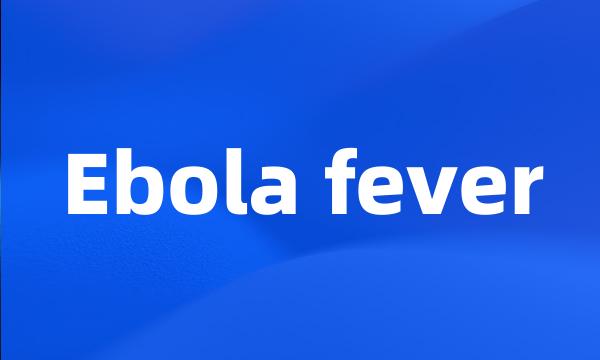Ebola fever
- n.埃博拉热病(致命出血热,由病毒引起)
 Ebola fever
Ebola fever-
Control of epidemics such as the Ebola fever through the World Health Organization ;
通过世界卫生组织防治伊波拉病毒热等流行病;
-
No specific treatment or vaccine is yet available for Ebola haemorrhagic fever .
埃博拉出血热目前还没有专门的疫苗。
-
Support from Red Cross volunteers has been instrumental in controlling large outbreaks of the closely related Ebola haemorrhagic fever .
来自红十字志愿人员的支持在控制密切相关的埃博拉出血热大暴发中发挥了作用。
-
Ebolavirus first came to light in1976 in outbreaks of Ebola hemorrhagic fever in and .
伊波拉病毒首次于1976年在扎伊尔和苏丹的伊波拉出血性高烧的爆发中露面。
-
WHO is familiar with such reactions , which have been seen during previous outbreaks of the closely related Ebola haemorrhagic fever .
世卫组织熟知在以前密切相关的埃博拉出血热暴发期间曾看到的此类反应。
-
The Government of the Republic of the Congo has officially declared the epidemic as due to Ebola haemorrhagic fever .
刚果政府官方宣布该国发生埃博拉出血热流行。
-
A enhanced team of national and international experts is being mobilized to implement control strategies for Ebola haemorrhagic fever and to support outbreak field response in the province .
正在动员由国家和国际专家组成的加强小组以实施埃博拉出血热控制战略并在该省支持现场疫情反应。
-
Marburg haemorrhagic fever is a severe and highly fatal disease caused by a virus from the same family as the one that causes Ebola haemorrhagic fever .
马尔堡出血热是一种严重和高致命性疾病,引起该病的病毒与导致埃博拉出血热的病毒同属。
-
With nations in West Africa facing the biggest and most complex outbreak of Ebola Hemorrhagic Fever in history , the United States is stepping up assistance to confront the disease .
随着西非国家面临历史上规模最大且病情最为复杂的埃博拉出血热疫情,美国加大援助对抗这种疾病。
-
The Ministry of Health ( MoH ), Uganda , has confirmed an outbreak of Ebola haemorrhagic fever , in Bundibugyo District , western Uganda .
乌干达卫生部证实了在乌干达西部本迪布焦区暴发了埃博拉出血热。
-
On13 May2011 , the Ministry of Health ( MoH ) of Uganda notified WHO of a case of Ebola Haemorrhagic fever in a12 year old girl from Luwero district , central Uganda .
乌干达卫生部于2011年5月13日向世卫组织通报了一起埃博拉出血热病例。病人为乌干达中部Luwero区的一名12岁女童。
-
Za ï re , Sudan and Bundibugyo species have been associated with large Ebola hemorrhagic fever ( EHF ) outbreaks in Africa with high case fatality ratio ( 25 – 90 % ) while C ô te d ' Ivoire and Reston have not .
扎伊尔、苏丹和本迪布焦种属与在非洲发生的埃博拉出血热(EHF)大型疫情有关,具有很高的病死率(25-90%)。而科特迪瓦和莱斯顿种属则没有这样高的病死率。
-
Some of the symptoms of Ebola include vomiting , fever , malaise , diarrhea , and there are cases of internal bleeding .
埃博拉病毒的症状包括呕吐、发热、不适、腹泻,有时也会内部出血。
-
The worst form of the disease kills nine out of ten victims . Ebola is a hemorrhagic fever . It causes unstoppable bleeding . It spreads through contact with blood and other bodily fluids .
这种病毒的死亡率可高达十分之九,埃博拉病毒是一种导致出血的病毒,可以导致不停的流血,它通过血液和其他体液传播。
-
Ebola is a hemorrhagic fever -- it can lead to bleeding inside and outside the body . Symptoms of the disease include high fever , and sometimes diarrhea . Other signs include weakness , muscle pain , headache and sore throat .
博拉病毒是一种出血热,能导致身体内外出血,症状包括高烧、呕吐和间或痢疾。
-
The grant , awarded by the National Institutes of Health , is meant to be a global collaboration to develop cocktails to fight Ebola and other hemorrhagic fever viruses such as Marburg , Sudan and Lassa viruses .
这笔奖金是由美国国立卫生研究院(NationalInstitutesofHealth)提供的,旨在通过全球合作开发出抗击埃博拉病毒和青猴病、苏丹亚型埃博拉病毒、拉沙病毒等出血热病毒的鸡尾酒疗法。
-
Ebola virus first emerged in 1976 in outbreaks of Ebola hemorrhagic fever in Zaire and Sudan .
埃博拉病毒最早于1976年在扎伊尔和苏丹地区爆发埃博拉出血热时被发现。
